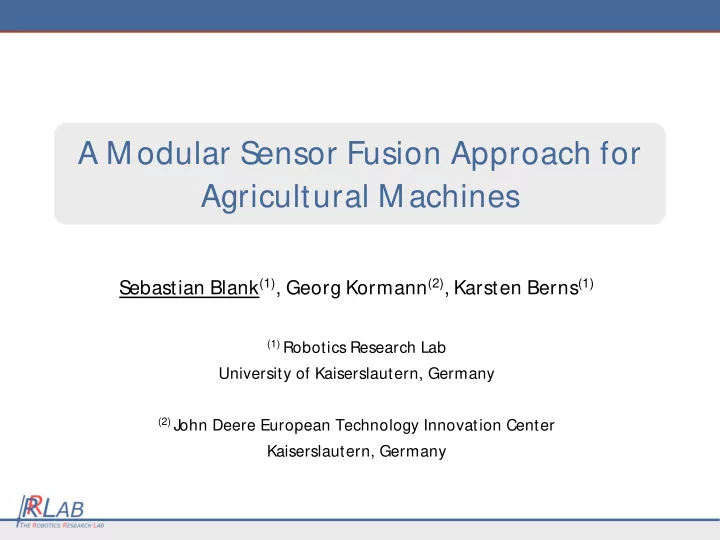

A Modular Sensor Fusion Approach for Agricultural Machines Sebastian Blank (1) , Georg Kormann (2) , Karsten Berns (1) (1) Robotics Research Lab University of Kaiserslautern, Germany (2) John Deere European Technology Innovation Center Kaiserslautern, Germany
Overview • State-of-the-art: data handling • Challenges • Derived Requirements • A modular approach to data handling • Conclusions/ Outlook A Modular Sensor Fusion Approach for Agricultural Machines
State-of-the-art: Data Handling • Primary applications (today) – telematics solutions – documentation • Assumptions: single vehicle centric � does not reflect actual usage pattern – static configuration � unable to process data from implement/ other machines – • Data acquisition: – hard coded: snapshot reflects only limited number of data sources averaging interval (typically 30s to few minutes) � potential is wasted – – bottleneck: data transfer from machine to off-board processing unit no/ little data fusion � conflicting data – A Modular Sensor Fusion Approach for Agricultural Machines
Motivation - Challenges • Heterogeneous machines large number of equipment OEMs � no common standard – isolated subsystems � limited machine-wide communication – • Future increase in: – number of data sources (sensors) – need for documentation degree of automation � (semi-)autonomous machines – • Further challenges – complexity challenge: current SW paradigm cannot keep up with HW development multiple sensor readings of same physical properties ( � inconsistent data) – – architecture gap: no mechanism for resolving data conflicts – no system-wide data visibility & accessibility – challenge will become even harder in the future A Modular Sensor Fusion Approach for Agricultural Machines
Derived Requirements • Uniform data handling / aggregation needed – scalable with host machine (low spec. vs. high spec.) – machine wide – high flexibility: modular design – automatic reconfiguration: no operator interaction – lean architecture & algorithms (limited comp. power) paradigm shift: vehicle centric � data centric (open interfaces) – • Potential benefits – robustness: reliable sensor data (utilize redundancy) task specific machine data processing (e.g. vehicle state � implement ) – – fully automatic: no need for manual configuration – ease future system design: abstraction & holistic concepts “We are drowning in information but starved for knowledge” (John Naisbitt) A Modular Sensor Fusion Approach for Agricultural Machines
Modular Approach To Data Handling • Tasks – system-wide & uniform approach for data management – ensure data consistency (low level fusion) – Integrated data processing/ aggregation • Data scopes – hardware information – domain/ process knowledge – little component knowledge inhibits usage of standard fusion approaches (e.g. Kalman filters) • Architecture – inspired by: biological fusion (human) & swarm intelligence – 3 levels: alignment, low-level fusion, high-level data aggregation/ interpretation – data centric: machine border dissolve – lean algorithms A Modular Sensor Fusion Approach for Agricultural Machines
Low-Level Fusion • Demand imposed by application: – robustness (failure & adaptation to changing environment conditions) – low computational demand – reliable & accurate results • Fuzzy voter approach – no assumptions/ models required – utilizes relative sensor distance – computational efficient: O(n²) – excellent robustness & accuracy – result + confidence metric (sensor monitoring) • Error detection/ correction – plausibility limits (domain knowledge) – dynamic thresholding (rejection mechanism) – adaptive weights assignment A Modular Sensor Fusion Approach for Agricultural Machines
Feature-Level Data Aggregation • 2-stage approach fuzzy classifier (deterministic) � state probabilities – Hidden Markov Model (probabilistic) � optimize w.r.t. transition sequences – – domain knowledge used to extract rule base – scales well with machine complexity – real-time capable with modest comp. power • Fuzzy classification – intuitive & computational inexpensive – interface to fusion: result confidence is considered – easily expandable (new/ different states) • Hidden Markov Model (HMM) – input: output of fuzzy classification offers more expressiveness (notion of time � sequences) – – computational inexpensive (pre-classified vs. raw sensor data) A Modular Sensor Fusion Approach for Agricultural Machines
Implementation • Components implemented in Matlab/ Simulink • Modular SW design • Interaction via lean interfaces • Independent loop times for low/ high level fusion – low level: loop time set dynamically per sensor group (sensor update rate) [approx. 1 -1000 ms] – high level: fixed loop time at startup (buffer mechanism) [approx. 5 ms - 100 sec] A Modular Sensor Fusion Approach for Agricultural Machines
Preliminary Test self-adaption & resulting error: • Simulated tests – focus: low level fusion algorithms (accuracy/ precision & robustness) – full system feasibility test: component integration • Rapid Prototyping Tests – so far: single component tests – modified utility vehicle + implement (reconf.) – HW platform: dSpace Autobox (loop time: 1ms) confidence variance: confidence vs. deviation: A Modular Sensor Fusion Approach for Agricultural Machines
Conclusions • Advantages – self-adjusting sensor fusion architecture – global (consistent) information scope platform independent (generic) approach � reuse – – machine complexity hidden from user (components supply meta information) – matches requirements of Ag applications – mapping of HW dynamics into data handling approach – embedded in iGreen Infrastructure (meta data/ result exchange) – integrated management solution for multicolored fleets • Outlook – full system test on real machine by end of 2011 – potential as supplement to ISOBUS standard A Modular Sensor Fusion Approach for Agricultural Machines
Thank you for your attention ! This work was partly funded by the German Federal Ministry of Education and Research (BMBF) in the context of the project iGreen (No.: 01 IA08005 P).
Recommend
More recommend